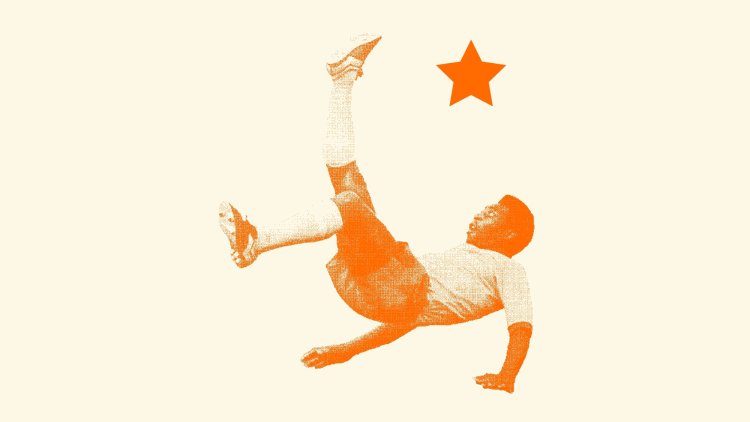When Soccer Was an American Afterthought
In a 1979 Atlantic article titled “Sportspeak,” soccer warranted only one sentence.

This is an edition of Time-Travel Thursdays, a journey through The Atlantic’s archives to contextualize the present and surface delightful treasures. Sign up here.
In 1979, Penny Pinkham wrote an article for The Atlantic titled “Sportspeak,” a brief overview that provided readers—specifically those who might be novices to the landscape of professional sports in America—with the necessary context and lingo to fake their way through dinner-party conversations. Rather than writing would-be entries for Encyclopedia Britannica, however, Pinkham took a slightly more unorthodox approach.
Excerpts include:
Baseball players wear tight-fitting uniforms in stretch fabrics and they often display bulging paunches along with the bulging cheeks. They spit a lot and spend a lot of time in the clubhouse playing cards.
Football players are called Bill or Steve, with a sprinkling of Bubbas. Their coaches are called Chuck.
Most basketball players went to college at UCLA or North Carolina, except for those over 6’10” whose first and last names begin with the same letter, who are allowed to come to play directly out of high school. Many basketball players have big round beds and long fur coats.
Pinkham also commented on hockey, tennis, golf, auto racing, and the Olympics, giving each sport a few paragraphs—each, that is, except soccer. For Pinkney, soccer warranted a single sentence: “You do not need to know anything about soccer yet, although you should be able to pronounce Pelé (Peh-lay).”
Such a brief allusion to what is now the most popular sport in the world may initially leave some contemporary readers miffed (me, I am the contemporary reader). But 45 years ago, soccer in the United States was nowhere near as beloved as it is today. Interest among Americans was spreading, to be sure, but relative to the other major sports, soccer was an afterthought.
Still, Pinkham’s single sentence is revealing in that it points to the fact that even casual sports fans who may not have known much about soccer in the late 1970s would (or should) have known about Pelé.
Midway through the 1975 season, Pelé—winner of three World Cups, scorer of more than 1,200 career goals, by then known by many as the greatest player to ever set foot on a soccer field—came out of retirement to join the New York Cosmos of the North American Soccer League (NASL).
“At that time, I had a lot of proposals to go to play in Europe, England, Italy, Spain, Mexico, but I said no. After 18 years, I want to rest because I’m going to retire,” Pelé said in an interview with CNN in 2011. “Then appeared the proposal to go to New York because they want to make soccer big in the United States. That was the reason … then I start my mission.”
In the season prior to Pelé’s arrival, the largest attendance at a New York Cosmos home game was about 8,000 people. In his final season, in 1977, the average attendance was more than 42,000 people for home games, including three instances in which there were crowds of more than 70,000. The Cosmos won the NASL championship in 1977, and Pelé was selected as an NASL all-star in each of his three seasons.
Although the NASL eventually folded in 1984, it laid the groundwork for today’s Major League Soccer, which formed in 1993. The league has followed a similar model of bringing in global superstars such as David Beckham, Thierry Henry, Wayne Rooney, Zlatan Ibrahimović, Gareth Bale, and Kaká. None of this would have been possible without Pelé.
The landscape of American soccer looks very different today. Earlier this week, I dropped my first-grade son off at school wearing his Paris Saint-Germain Kylian Mbappé jersey, and he ran straight to his friend, who was wearing an Inter Miami Lionel Messi jersey. Behind them, a kindergartener walked through the school entrance wearing a Manchester City Erling Haaland jersey. The global game has penetrated the consciousness of American children and adults in ways rarely before seen in our country, and it shows no sign of slowing down, especially with the World Cup being hosted in North America in 2026.
The proliferation of streaming and social media has made it possible to watch almost any game in the world at any moment. With YouTube, fans have instant access to the highlights of games from half a century ago. My son has personally committed to watching highlights of every goal scored in every World Cup as far back as YouTube will take him. Most recently, he watched the highlights of the 1958 World Cup, where a skinny, little-known 17-year-old from Brazil lit up the tournament by scoring six goals, including two in the World Cup final. His name was Pelé. Or, shall we say, “Peh-lay.”
What's Your Reaction?




















